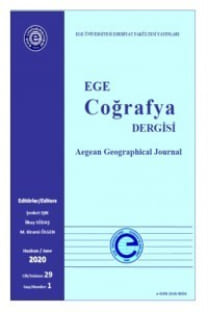GÜNEŞ LEKELERİ ÎLE İKLİM UNSURLARI ARASINDAKİ İLİŞKİLER ÜZERİNE BİR İNCELEME: İZMIR ÖRNEĞI (1942-1963)
Türkçe Özet yoktur.
A Study on Relationships between Sunspots and Climatic Elements in Izmir (19421963)
The mean annual BAUR’s solar index and the mean annual solar faculae is considered in order to evaluate the climatic elements such as the mean solar radiation balance, temperature, actual air pressure, annual precipitation and potential evaporation. These data are evaluated by the statistical methods. According to this study, the following results are obtained:1. An international period that is considered between 1901 and 1930 is not appropriate in order to statistical methods because of the fact that the trend period is continued as long as 1933. According to our statistical studies, the period covering 1889-1941, 1897-1927, 1901-1933, 1934-1964 and 1942-1963 are appropriate for the evaluating of the relationships between sunspots and climatic elements. In this study the period 1942-1963 is chosen to evaluate the climatic elements of Izmir.2. There is a strong relationship between sunspots and solar faculae. The correlation index is 83 %.3. The solar radiation intensity increase according to the increase of sunspots. The intensity of the radiation changes from one period to another (correlation index 68 % to 99.9%).4. The annual changes of relative number of the sunspots and solar faculae are about 97 % for only 1942 and 1963. While the changes of the climatic elements for the same period are 31 and 80.5. The periods that sunspots were maximum as is 1957, the climatic elements were affected by the solar radiation. The periods that the decrease of the sun radiation in response to effects of the climatic elements were delayed. This period ranges between 1 to 4 years6. The effects of the sunspots on the climatic elements changes from one climatic elements to another in the comparison period covering 1942-1963. As a general rule, this effects of the sunspots is more the temperature-heat groups than the precipitation groups. For example, the increase of the sunspots produces an increase of solar radiation (Qg) in the ratio of 47 % and temperature (t) 56 % and the balance of solar radiation (Eb) 63 %. This effect is about 30 % on the actual air pressure (P) and on the potential evaporation (E) 37 %. On the other hand, the increase of the sunspots bring about of an decrease of precipitation (R) in the ratio of 22%.As a result, there is a strong relationship between sunspots and climatic elements, especially in terms of temperature and precipitation. The reaction of the sunspots on the climatic elements delay between 1 and 4 years. In other words, delaying period cover a period changing 1 and 4 years.
